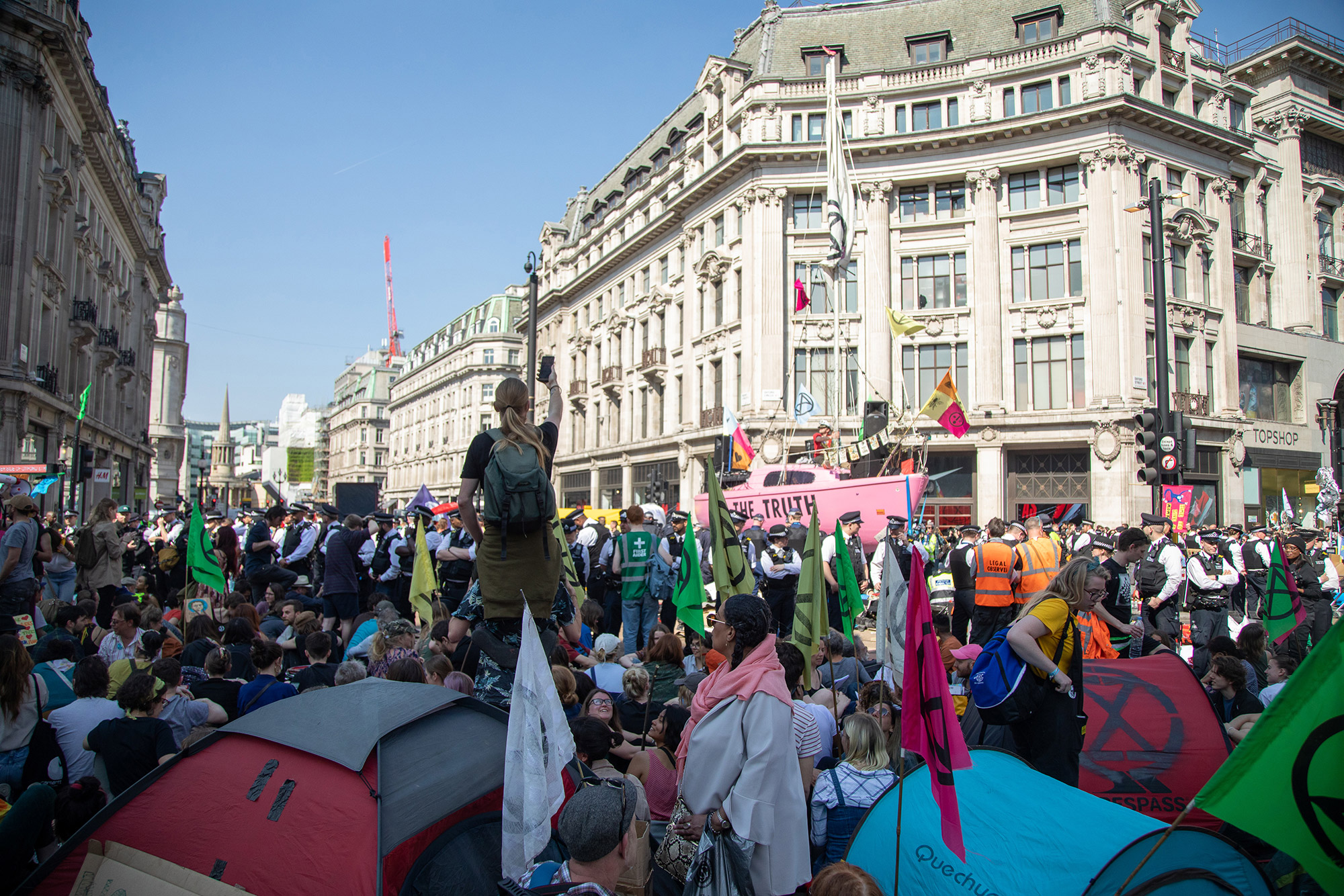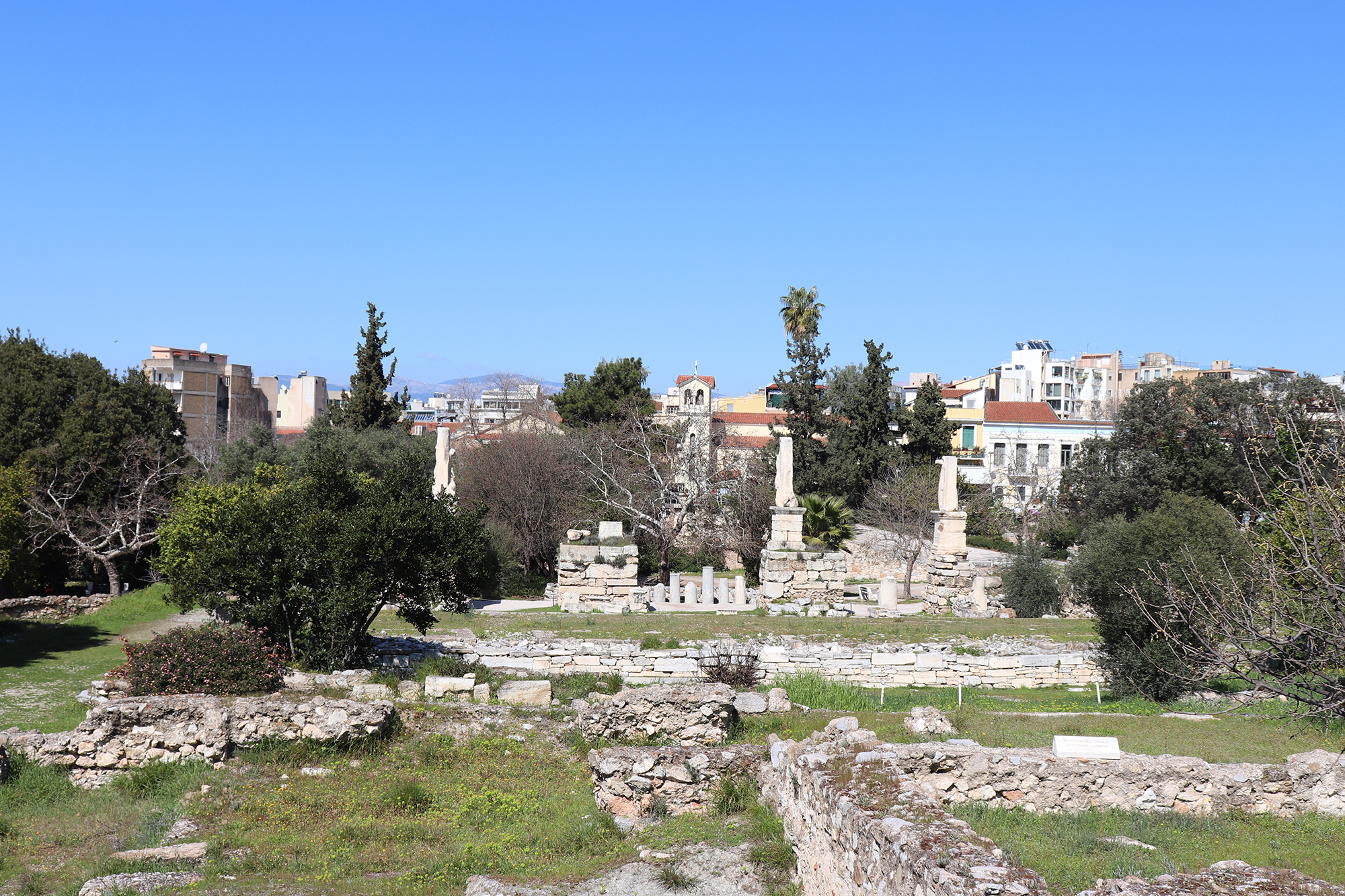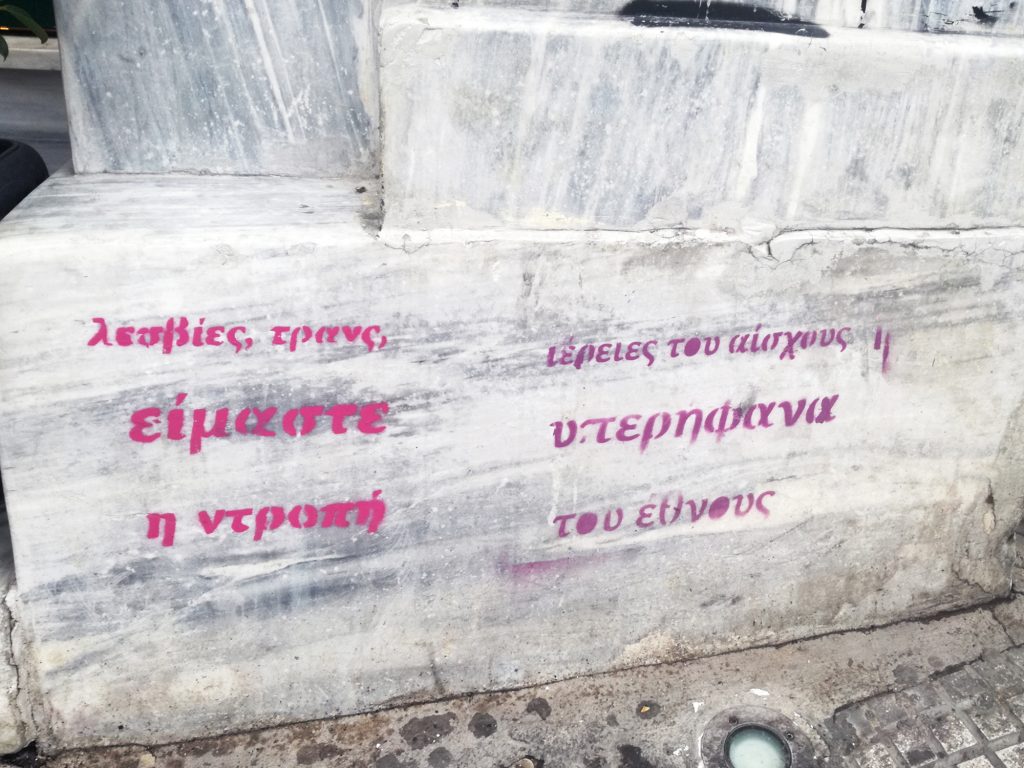
Infrastructures for Voice
Fani Kostourou and John Bingham-Hall
We speak. Whether with our voices, our hands or through technologies, speaking is inseparable from being human. When do our words become political? Politics can be in what we say, but it can also be in the places and ways in which we speak. If the same words are delivered from a pulpit or over a kitchen sink, they don’t carry the same meaning. Cities have speech too – they translate what we say via their own language, each having a unique syntax made up of its particular configurations of spaces, cultures, infrastructures, and technologies.
So, what kinds of spaces make our words political? Who has access to them? And how do those excluded from those spaces find ways to amplify their voices?
These were some of the questions posed in Athens to the invited residents that took part in ‘The City Talks Back’ creative research programme. ‘The City Talks Back’ is a collaborative project initiated by our London-based urban research organisation Theatrum Mundi, and hosted by Athens-based cultural foundation Onassis Stegi. Over one year, we brought together architects, urbanists, activists, artists, and anthropologists to explore social and political voicings of contemporary Athens.
The project consisted of several stages supporting the development, creation and presentation of new works by the international group of participants. The initial research residency (January 2020) explored the city and its contemporary challenges, and established connections between the participants and local initiatives. The second residency (March 2020) allowed for the development and sharing of the works-in-progress. Later in the year, Assembly 01 – the first public phase of the project – featured new works by the invited residents, addressing issues as broad as political protest, displacement stories, domestic narratives of refugees, women’s safety in public spaces and migrant citizenship through scripts, films, sound works and more. Alongside a programme of live performances and discussions, all hosted in a new microsite, backtalks.city. Edited and curated by George Kafka, the website was launched in September 2020.
Nearly a year later, in June 2021, Assembly 02 followed suit, taking the form of a 3-day radio broadcast hosted by Movement Radio, an international online radio station based in Athens. Exploring ways of assembling, public speaking and listening, we shared new performances, translations, films and discussions exploring again the city’s political speech, whilst physical gathering in public spaces was still uncertain or denied.
In what follows, we offer a series of provocations that framed the research residencies at the beginning of the project. We see them as ideas to think with and about different configurations of voices, spaces, and technologies. Each one is a possibility – a structure of communication, that links the different works together whilst serving as a strategy or as a warning. They are all intended as invitations to read further, to put into action, or to question who is (and isn’t) heard in the city and how the audibility of voices changes across the city’s varying spaces. These provocations also form part of Theatrum Mundi’s own inquiry and interest in developing a framework for sonic urbanism; that is an urbanism concerned with sounds, voices, and communication as a starting point for framing urban design questions.
Provocation 1. Urban configurations as infrastructures for protest
Cities can emerge from collective life and engender collective politics and ownership. But they can also be (re)planned from the top down, making them easier to control. In this sense, we can think of the configuration of cities like an infrastructure for political voice, that can be manipulated to make it easier or harder to be heard.
According to economic geographer David Harvey1, it is clear that: “certain urban environmental characteristics are more conducive to rebellious protest than others – such as the centrality of squares like Tahrir, Tiananmen, and Syntagma, the more easily barricaded streets of Paris compared to London or Los Angeles, or El Alto’s position commanding the main supply routes into La Paz. At the same time, reconfiguring cities and their public spaces, framed often as a question of public health, can also be an act of control of urban populations. This was most famously the case with Haussmann’s boulevards in Paris, which were viewed even at the time as a means of military control of rebellious citizens. This case is not unique. The re-engineering of inner cities in the United States in the wake of the urban uprisings of the 1960s just happened to create major physical highway barriers – moats, in effect – between citadels of high-value downtown property and impoverished inner-city neighbourhoods. The violent struggles that occurred in the drive to subdue oppositional movements in Ramallah on the West Bank (pursued by the Israeli IDF) and Fallujah in Iraq (pursued by the US military) have played a crucial role in forcing a re-think of military strategies to pacify, police, and control urban populations. […] The urban obviously functions, then, as an important site of political action and revolt. The actual site characteristics are important, and the physical and social re-engineering and territorial organization of these sites is a weapon in political struggles”.
Similar spatial strategies have also been adopted by urban populations and demonstrators. Learning the characteristics of the city, and appropriating them to their benefit, is one way for citizens to multiply the impact of their protest. In London, rallies traditionally march from Parliament Square to Trafalgar Square along Piccadilly. These are the symbolic spaces of political representation in the city, with a long history of protest. They are, however, not necessarily crucial to transport in the city. Huge numbers of people are needed to fill them and leaving them half empty only risks proving the lack of support for a cause. In 2018, Extinction Rebellion took a different approach. With a small number of people, they blocked Waterloo Bridge and Oxford Circus, key points in the traffic network of the city, or what we can call ‘instrumental spaces’ – being more ‘useful’ than ‘symbolically meaningful’. Their presence rippled through the city, affecting traffic for miles around. A gathering of 100 had more practical impact on the city than a parade of 100,000 on Piccadilly. They had to be listened to. Even more dramatically, in 2018, a single drone flown by an unknown operator caused the shutdown of Gatwick Airport in London, stopping hundreds of flights. It was speculated that this might also be an environmental protest but it turned out to be a local couple with no apparent motive. Either way, they showed how an individual can amplify their actions by aiming them at new infrastructural centralities. Does protest need to learn the changing configurations of the built environment to be heard? Does it need to leave behind or upgrade its traditions, and focus on the new infrastructural connections that really keep cities moving?
In his ‘The City Talks Back’ contribution ‘Παγκόσμια Ηχώ | Echos-Monde | The World is Echo’, activist and ethnomusicologist Tom Western investigated Athens’ Omonoia square as a circular focal point, a central node that works as a swirl of Athenian life, gathering and then redistributing long histories of movement, encounter, exchange, and dissent – “όλη η Αθήνα βρίσκεται στην Oμόνοια μέσα” [Omonoia contains all of Athens], as Nicolas Calas wrote in 1933. This was tangibly linked to Tim Ward’s ‘Route One’ piece, which traced a journey through the Athens suburbs in the times of lockdown, when free movement in the city was halted and suburban dwellers were cut off from the crowded voices of central neighbourhoods. How do configurations of voice vary from centre to edge?
Provocation 2. Communicative configurations for protest and occupation
Whilst protests are public performances that reproduce already-rehearsed ideas, occupations are more self-contained: collectively-produced commons that work to generate new politics. To explain further, a protest could be described as an exclamation; a performance directed outwards to an attending crowd. The ground it takes place on is used as a temporary stage whose value lies in the visibility of its location to the public. Occupation, on the other hand, attempts to enact a new reality, to claim ownership over its ground. It directly defies law to claim that ‘we’ can gather ‘here’ in ‘this space’ for ‘a period of time’. By occupying a space, the ground itself – who owns it, what it can be used for, for how long – is foregrounded and contested. The persistence of different groups and their improvised dynamics on the same ground make occupations visible; yet, they are turned inwards, around deliberation and the development of new shared (or conflicted) ideas.
In scenes from an occupation, writer Eli Schmitt and filmmaker Astra Taylor provide a vivid image of the different reality of occupation in relation to protest2. Schmitt relates that: “The group had congregated at Zuccotti Park, at Liberty Plaza, a paved rectangle between Broadway and Trinity Place, and looked to be at least a few hundred strong. Instead of a single, unified congregation, there were smaller circles of ten to fifty people, some with megaphones. Some circles had moderators and agendas, others appeared to be more spontaneous”.
But then, Taylor remembers that, once the crowd was dispersed: “I followed an impromptu procession into the park where they are now encamped. I hooked up with a group of friends and we had an ‘assembly’ with a bunch of strangers and talked economics for two or three hours. It was kind of nice to be at a protest and, instead of marching and shouting, to be talking about ideas”.
Human configurations as infrastructures for political voice are vital not only in the way they occupy space in cities – i.e. smaller circles or unified congregations – but also in the means they employ to band together and engage in acts of speaking, listening, and talking back. When devices such as speakers and microphones are legally banned in a public space, a crowd can use its own vocal practices to amplify a message, and in this process, it turns itself from a passive transponder into an active participant of an ‘acoustic community’.
Artist and musician Sharon Phelan3 wrote: “On a balmy autumn night in New York, 2011, a speaker prepares to address the crowd at Occupy Wall Street (ows) in Zuccotti Park. She calls the assembled crowd to silence with the now iconic call – “Mic Check! Mic Check!” – to which the gathered crowd immediately echo in response. She proceeds to organise her speech into short bursts in order to maintain a rhythm that can be reproduced by hundreds of people in waves across the camp. The people duly respond and repeat every word in unison, concentrically outwards from the speaker in a ‘citational chain’, and in the process transform themselves into an instrument: a human microphone”.
But do smaller configurations and their shared ideas fit within wider efforts and unified messages? Is there a space in cities to perform both?
Occupy Wall Street – Mic Check. Source: NYU Local (Wikimedia Commons CC BY)
Departing from these questions, artist Urok Shirhan’s ‘Lovesong Revolution’ essay explored public broadcast as a structure of communication. How can mass media make a space for sharing intimate thoughts between allies? Is there a space in the public sphere for those unamplified voices inside our heads? Can, as she asks, a love song start a revolution? Following that, The Syrian and Greek Youth Forum (SGYF), an international activist movement based in Athens, produced ‘Becoming the City’, a film on communicative methods. By taking sound technologies and performances to the street, for example, they amplify their voices and assert their status as citizens in a city that may not formally have recognised them as such.
Provocation 3. Institutional and architectural staging
Staging is an architectural gesture underpinned by an institutional infrastructure. A stage can be a raised platform or a sunken pit surrounded by raised seating. Like standing on a balcony, being raised up can make you either an observer or an actor. Either way its aim is to focus attention in one place. Many architectural elements of the city could have the same effect. But some stages also have institutional infrastructures underpinning them, adding power to attention. The stage of a national assembly confers more political power than that of a neighbourhood assembly room, even though spatially they may be similar. In the central political stage of the city or nation, a single voice could set the terms of national debate. The Pnyx of Athens is an illustrative example. In contrast to the democratic mass of the Athenian Agora, where all could speak but none was heard, the Pnyx allowed one to speak to many. Capitalising on its natural acoustics and its vantage point over the city, it was a focused space to retreat from the compression of bodies in the street and give space to one voice.
Here, unlike in the Agora, a crowd can be politicised, but as sociologist Richard Sennett4 argues they can also become dominated: “The modern word ‘theatre’ derives from the Greek ‘theatron’ meaning a space for looking at, for observing with spectators separated from an actor. In the amphitheatre, the orchestra, or dancing place, consisted of a circle of hard earth at the bottom of the dan of seats. When in the fifth century BC the Pnyx came to house political gatherings as well as plays, Athens’ 6000 citizens sat still on stone benches for hours at a stretch, listening to sustained voices at the bema, a podium space, following the narrative thread of a play or an argument. Sitting was thought to be a passive position one in which the audience took things in. From the two positions of the human body – standing and sitting – the Greeks drew the distinction between actor and spectator; these were thus fundamental categories for them in life as well as art”.
The Pnyx in Athens, March 2020. Source: John Bingham-Hall
The Pnyx in Ancient Athens was a sequential space because – while sitting – a citizen could take in a long, linear unfolding of words. Moving upright in the synchronous space of the Agora (instead) they could hear only snatches of conversations, words in fragments. These spaces thus embodied contrasting dangers. Plato feared the mind-numbing power of rhetoric in the Pnyx; the passive, seated crowds could become victims of words, paralysed and dishonoured by their unrelenting flow. The Agora, conversely, was mind-numbing in a cognitive rather than a rhetorical way, since there was a pile-up of disconnected impressions; Plato again counselled young men to concentrate both physically and mentally by leaving the Agora and going to the calmer space of the gymnasium where fewer things were going on. The danger in a sequential space was emotional domination, while in a synchronous space it was intellectual fragmentation.
So why does the Pnyx no longer play this role? As the sound recording in the video shows (The Pnyx in Athens, March 2020. Source: John Bingham-Hall), it is still a quiet space in which the voices of humans and non-humans alike can be heard above the noise of the city far below. It still hosts gatherings and discussions. But it is no longer underpinned by the infrastructure of political institutions, so the voices heard here can no longer dominate.
As a response to Assembly 01, urbanist Fani Kostourou and director for stage and film Eleanna Santorinaiou created ‘Ακούς την Αθήνα; | Do you hear Athens?’, a 24-hour sound piece which saw the typical Athenian balcony as a stage that trains citizens in acts of listening in both attentive and inattentive ways. As threshold stages, balconies lie between the domestic and the public and balance between emotional domination and intellectual fragmentation.
Provocation 4. Linguistic infrastructure to sonic expression
Spontaneous and expressive political movements are nowadays wrapped up with social media and often get globalised in their formats and concerns. By lacking a long-term vision and organising capacity, they are concerned with individual voices expressed in local languages. As our most urgent political questions globalise, like extractive capitalism and environmental destruction that do not respect the thresholds between linguistic spaces, do we need an even more global language for protest? Or do we need more localised forms of political voice, that adopt the language of a city and learn over time how to develop a sustainable place within its politics?
In her book, sociologist Zeynep Tufecki5 mentions: “In Istanbul in 2013, I was struck by how the protestors’ language about technology, protests and politics resembled those of protestors elsewhere in the world, even though such spontaneous protests had no true Turkish historical counterpart. Egyptian youth and New York youth, different in many ways, also sounded similar themes in discussions: anti-authoritarianism, distrust of authority, and desire for participation. These grievances powering the rebellions were wrapped up in the possibilities of connections and voice afforded by phones they carried everywhere. Globalization from below had arrived. A come-from-seemingly-nowhere protest of this scale was very novel for Turkey, which had no substantial previous political culture of large, leaderless movements. In Gezi, I was seeing the product of a global cultural convergence of protestor aspirations and practices. If I squinted and ignored that the language was Turkish, I felt that it could have been almost any twenty-first-century protest square: organised through Twitter, filled with tear gas, leaderless, networked, euphoric, and fragile”.

Seller of gas masks and goggles at Taksim Gezi Park on 4th June 2013. Source: VikiPicture (Wikimedia Commons CC BY-SA)
While digital technologies and social media platforms, like Twitter, may empower, organise, and bring visibility to political movements, they also homogenise the linguistic and bodily forms through which individual voices and gestures express temporal experiences. But voices are extensions of identities and cultures, characterised by languages, genders, beliefs, and traditions.
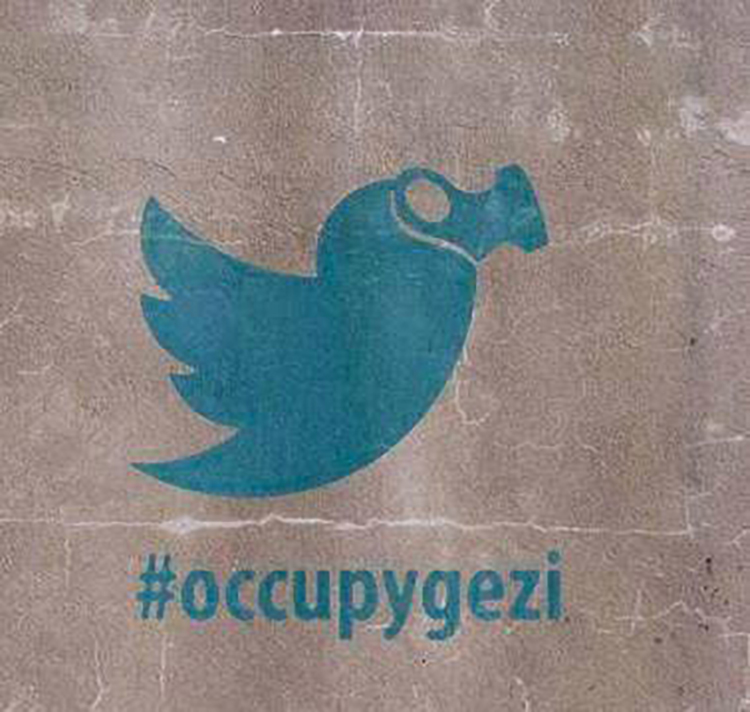
Twitter logo bird wearing a gas mask. #occupygezi hashtag. Digital artwork mimicking street graffiti widely circulated on social media. Source: Twitter
Our voices can tell stories, which are ways of talking about our experience of the world and our hopes for something different. But this is not all they do – sometimes they emit noise without words, often to express our most primal emotions. Care, fear, rage, ecstasy, bubble out from us as sounds we often do not pre-conceive or control. When we speak discursively, we pass on information, conjuring up images of abstract ideas or past times and places. When we shout or scream, there is no information but there is meaning – we affect emotions on others that allow for a resonance with how we feel. What is the role of the discursive and of the affective in narrating?
Philosopher Jacques Rancière6 tells a mythical story about how the separation of signal and noise might have been accomplished in Ancient Greece. Sounds produced by affluent male ‘citizens’ were defined as speech, whereas women, children, slaves, and foreigners were assumed to produce garbled noise. “In order to refuse the title of political subjects to a category—workers, women, etc.—it has traditionally been sufficient to assert that they belong to a ‘domestic’ space, to a space separated from public life; one from which only groans or cries expressing suffering, hunger, or anger could emerge, but not actual speeches demonstrating a shared aisthesis. And the politics of these categories … has consisted in making what was unseen visible; in getting what was only audible as noise to be heard as speech”.
In his sound work ‘vox populi vox dei’, anthropologist Yorgos Samantas explored the rhythmic dimension of political slogans, whose sensorial effect on a crowd transcends the linguistic content of the statements they make. On the contrary, artist Ella Finer in ‘her moon is a captured object’ drew attention to the way meanings are changed as they circulate through linguistic translations. As Luce Irigaray says, in one of the quotes she cited: “If we keep on speaking the same language together, we’re going to reproduce the same history”. Similarly, the loose script written by artists Mercedes Azpilicueta and Angeliki Tzortzakaki, ‘Priestess of disgrace, you bring joy into my life’ also rested on translations of overheard phrases and benedictions uttered by women in Athenian marketplaces between English and Greek. All these three contributions called for reclaiming the non-linguistic, the rhythmic, the misunderstood and the translated as tools for combining our voices with those of others.
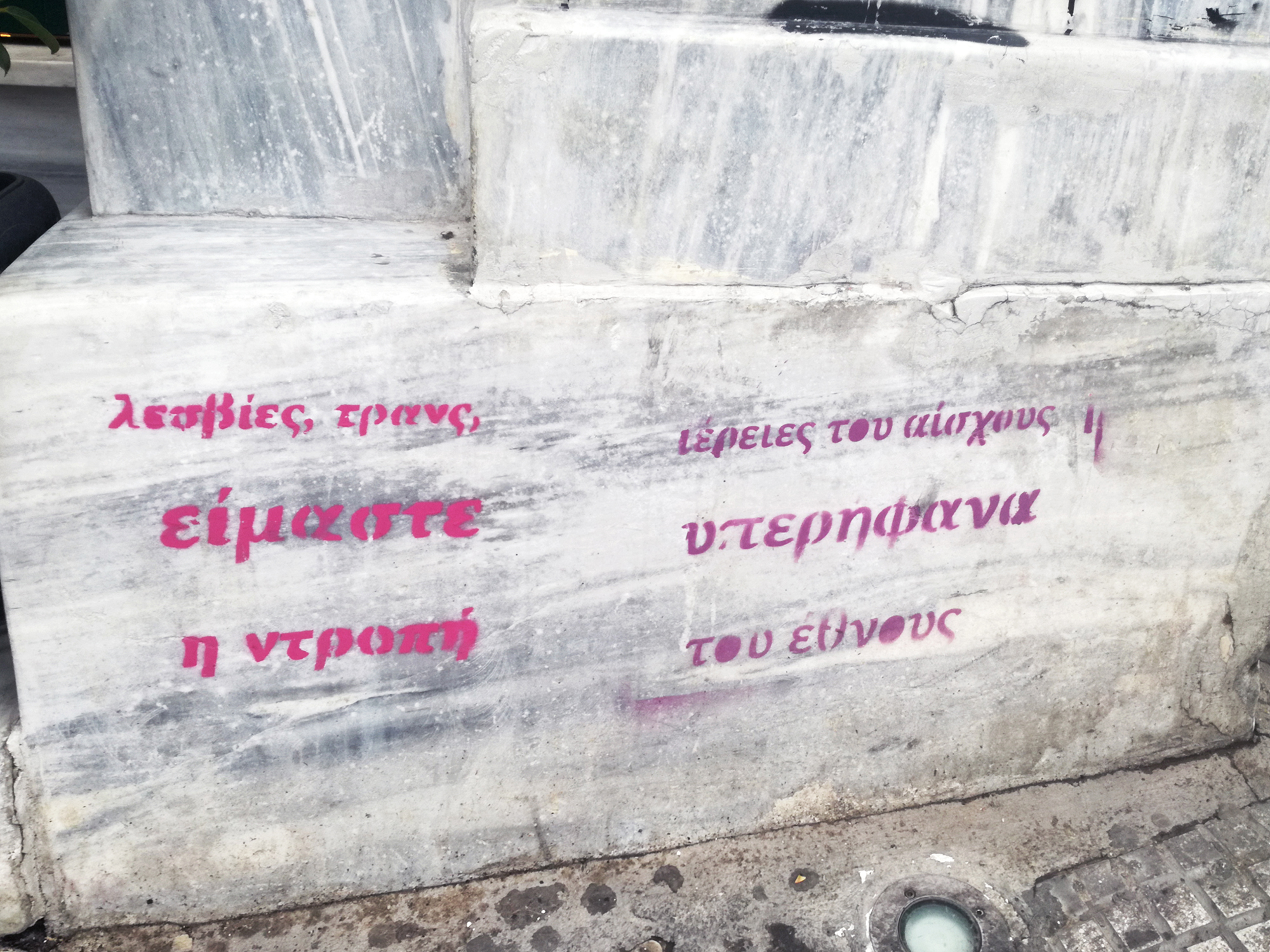
Stencil on a marble in Monastiraki, Athens, reading “λεσβίες, τρανς, ιέρειες του αίσχους, είμαστε υπερήφανα η ντροπή του έθνους”, translating in “lesbians, trans, priestesses of disgrace, we proudly are the shame of nation”. March 2020. Source: Angeliki Tzortzakaki
Provocation 5. From backstage speech to public voice
Where does speech begin? In the relationship between parent and child, in mimicking and cooing, the need for food, shelter, and community within a home.
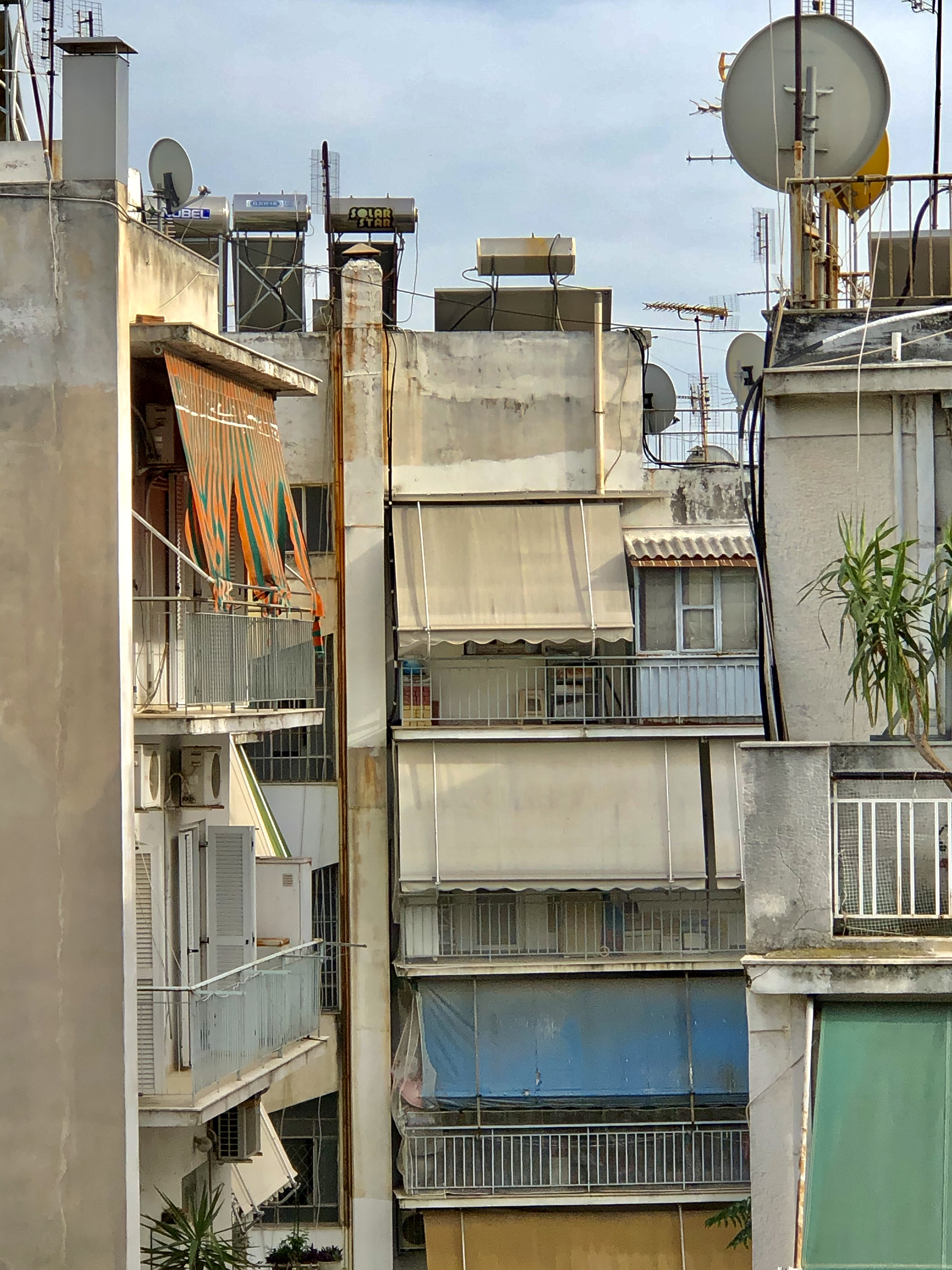
Athenian polykatoikies (apartment blocks, for the ‘Athens Tesselation’ project. Source: Ahmad Askaryzadeh
The home is the infrastructure underlying the development of speech, yet the domestic voice is not the one given the political stage. If domestic labour is still performed mostly by women, then political speech itself is gendered. Speech is made voice by stepping into public, and the public was made by men so that women’s speech could be confined to the home. Feminist writer and social activist bell hooks7 describes the process to make her voice, only to find it was not welcome in public:
“In the world of southern black community I grew up in “back talk” and “talking back” meant speaking as an equal to an authority figure. It meant daring to disagree and sometimes it just meant having an opinion. In the “old school” children were meant to be seen and not heard. My great-grandparents, grand- parents, and parents were all from the old school. To make yourself heard, if you were a child, was to invite punishment, the backhand lick, the slap across the face that would catch you unaware, or the feel of switches stinging your arms and legs. To speak then when one was not spoken to was a courageous act – an act of risk and daring. And yet it was hard not to speak in warm rooms where heated discussions began at the crack of dawn, women’s voices filling the air, giving orders, making threats, fussing. Black men may have excelled in the art of poetic preaching in the male dominated church but in the church of the home where the everyday rules of how to live and how to act were established it was black women who preached. There, black women spoke in a language so rich, so poetic, that it felt to me like being shut off from life, smothered to death if one was not allowed to participate. It was in that world of woman talk (the men were often silent, often absent) that was born in me the craving to speak, to have a voice, and not just any voice but one that could be identified as belonging to me. To make my voice I had to speak, to hear myself talk – and talk I did – darting in and out of grown folk’s conversations and dialogues, answering questions that were not directed at me, endlessly asking questions, making speeches. Needless to say, the punishments for these acts of speech seemed endless. They were intended to silence me – the child – and more particularly the girl child. Had I been a boy they might have encouraged me to speak believing that I might someday be called to preach. There was no “calling” for talking girls, no legitimized rewarded speech. The punishments I received for “talking back” were intended to suppress all possibility that I would create my own speech. That speech was to be suppressed so the “right speech of womanhood” would emerge”.
Thinking of homes as stages for speaking, listening and talking back, architects Stefania Gyftopoulou and Mara Petra in collaboration with participants from the City of Athens’ Curing the Limbo integration programme, produced ‘Athens Tessellation’, mapping home stories of refugees living under diverse conditions in Athens. Its aim was to turn domestic speech into a political voice, which claims the right to housing and home-making. Whilst being a crucial political struggle, the narration of its everyday reality takes place away from spaces of public political debate, and in living rooms and kitchens across the city neighbourhoods. How can new technologies and cartographies of the city change the uneven and gendered geographies of voices that speak for the right to housing?
Conclusion
From the official public space of democratic assembly in Ancient Greece to the bedrooms of refugee houses in contemporary Athens and from protest slogans to everyday speech, the five provocations reveal the antagonistic relationship between vocal configurations, physical stages, and the power dynamics that control the two across different scales in the city. If we consider the spectrum of the individuals’ social experiences and encounters as well as the similarities and differences in the way these are addressed, voiced and countered trans- and cross-culturally, we could imagine that although contextual, these works –and their reflections– could find resonance in different cities within and beyond Europe. Because even though they all anchor in Athens, they speak multiple languages, echo many kinds of sources meaningful to many audiences, carry shared meanings and stories, create solidarities across borders and disseminate creative strategies for political speech despite spatial limitations.
Notes
1. Harvey, D. (2012). Rebel cities: From the right to the city to the urban revolution. New York: Verso Books, p. 117.
2. Schmitt, E., Taylor, A., and Greif, M. (2011). Scenes from an occupation. In: C. Blumenkranz, K. Gessen, M. Greif, S. Leonard, S. Resnick, N. Saval, E. Schmitt, and A.Taylor, eds., Occupy!: scenes from occupied America . New York: Verso Books, pp. 2-3.
3. Phelan, S. (2019). Echoes and resonances in the acoustic community. In: &beyond, eds., Sonic Urbanism. London: Theatrum Mundi, p. 60.
4. Sennett, R. (2018). Building and dwelling: ethics for the city. New York: Farrar, Straus and Giroux, 206-208.
5. Tufekci, Z. (2017). Twitter and tear gas: The power and fragility of networked protest. London: Yale University Press, pp. xiv-xv.
6. Rancière, J., Davide P., and Rachel B. (2001). Ten theses on politics. Theory & Event, 5(3), p. n.p.
7. Hooks, b. (1989). Talking back: Thinking feminist, thinking black. Boston: South End Press, p. 426.
+
The City Talks Back is a project by Theatrum Mundi and Onassis Stegi. Curators: John Bingham-Hall and Fani Kostourou (Theatrum Mundi), Christos Carras and Pasqua Vorgia (Onassis Stegi), George Kafka. Participants: Mercedes Azpilicueta, John Bingham-Hall, Ella Finer, Stefania Gyftopoulou, Fani Kostourou, Mara Petra, Yorgos Samantas, Eleanna Santorinaiou, Maria Sideri, Urok Shirhan, The Syrian and Greek Youth Forum, Angeliki Tzortzakaki, Tim Ward, Tom Western. An earlier version of this article appeared in September 2020 on the backtalks.city website. The text was used to frame ‘The City Talks Back’ project, linking the various project contributions with critical theory to explore problems within the staging of voices in the city. A creative research programme led by Onassis Stegi and Theatrum Mundi, The City Talks Back brought together architects, urbanists, activists, artists, and anthropologists to explore the voicings of contemporary Athens. The project questions who is and isn’t heard in the city and how the audibility of voices changes across the city’s varying public spaces. We invite everyone to enjoy the contributions online.
Fani Kostourou, Dr. is Associate Director at Theatrum Mundi and Associate Lecturer at the University for the Creative Arts and UAL Central Saint Martins. She is trained as an architect and urbanist at NTUA, ETHz and UCL, holding a PhD in Architecture and Urban Studies from UCL Bartlett. Fani conducts research, engages in curatorial and editorial work, publishes and exhibits internationally on design, computation, critical spatial theories, housing, social behaviours and urban cultures. She has previously worked in Cardiff University, UCL Bartlett, and the CANactions School for Urban Studies.
John Bingham-Hall, Dr. is co-Director of Theatrum Mundi and an independent researcher interested in performances, infrastructures, and technologies of shared life in the city. With a background in music (Goldsmiths) and architectural theory (UCL Bartlett), he works across artistic, spatial and critical humanities to question and participate in the making of the urban public sphere. Alongside initiating projects with Theatrum Mundi, John has collaborated on research projects at LSE and Oxford, taught at CSM and UCL, published writing across scholarly and arts platforms; and organised queer cultural events.
Volume 5, no. 1 Jan-Jun 2022

